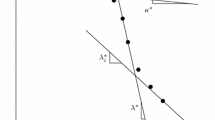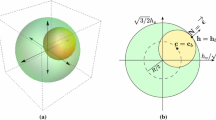Abstract
This paper presents a strain-rate dependent plastic constitutive model for clays. Based on the concepts of critical-state soil mechanics and bounding surface plasticity theory, the model reproduces the mechanical response of clays under triaxial and simple shear loading conditions. The model parameters are determined for Boston Blue Clay, London Clay and Kaolin Clay, and the performance of the model in simulating the mechanical response of these clays is demonstrated for low to medium strain rates. The sensitivity of each model parameter is checked by perturbing the calibrated values by ±20 %. Subsequently, a probabilistic analysis using Monte Carlo simulations is performed by treating the model parameters as random variables and the impact of the statistics of the parameters on the undrained shear strength is investigated.















Similar content being viewed by others
References
Adachi T, Oka F (1982) Constitutive equations for normally consolidated clay based on elasto-viscoplasticity. Soils Found 22(4):57–70
Been K, Jefferies MG (1985) A state parameter for sands. Géotechnique 35(2):99–112
Biscontin G, Pestana JM (2001) Influence of peripheral velocity on vane shear strength of an artificial clay. ASTM Geotech J 24(4):423–429
Chakraborty T (2009) Development of a clay constitutive model and its application to pile boundary value problems. Ph.D. Thesis, Purdue University, West Lafayette, Indiana, USA
Dafalias YF (1982) Bounding surface elastoplasticity-viscoplasticity for particulate cohesive media. In: Vermeer PA, Luger HJ (eds) International union of theoretical and applied mechanics conference on deformation and failure of granular materials, pp 97–107
Dafalias YF, Manzari MT (2004) Simple plasticity sand model accounting for fabric change effects. J Eng Mech ASCE 130(6):622–634
Dafalias YF, Papadimitriou AG, Li XS (2004) Sand plasticity model accounting for inherent fabric anisotropy. J Eng Mech ASCE 130(11):1319–1333
Dafalias YF, Manzari MT, Papadimitriou AG (2006) SANICLAY: simple anisotropic clay plasticity model. Int J Numer Anal Methods Geomech 30:1231–1257
Díaz-Rodríguez JA, Martínez-Vasquez JJ, Santamarina JC (2009) Strain-rate effects in Mexico City soil. J Geotech Geoenviron Eng ASCE 135(2):300–305
Gasparre A (2005) Advanced laboratory characterization of London clay. Ph.D. Thesis, Imperial College London
Gasparre A, Nishimura S, Coop MR, Jardine RJ (2007a) The influence of structure on the behaviour of London clay. Géotechnique 57(1):19–31
Gasparre A, Nishimura S, Minh NA, Coop MR, Jardine RJ (2007b) The stiffness of natural London clay. Géotechnique 57(1):33–37
Hájek V, Mašín D, Boháč J (2009) Capability of constitutive models to simulate soils with different OCR using a single set of parameters. Comput Geotech 36:655–664
Hambly EC (1972) Plane strain behaviour of remoulded normally consolidated Kaolin. Géotechnique 22:301–317
Hardin BO (1978) The nature of stress-strain behavior of soils. In: State-of-the-Art Report, Proceedings of the ASCE specialty conference on earthquake engineering and soil dynamics, Pasadena, pp 3–90
Hight DW, McMillan F, Powell JJM, Jardine RJ, Allenou CP (2003) Some characteristics of London clay. Characterization of engineering properties of natural soils, Balkema, pp 851–908
Hinchberger SD, Rowe KR (1998) Evaluation of the predictive ability of two elasticviscoplastic constitutive models. Can Geotech J 35:769–789
Hinchberger SD, Qu G, Lo KY (2010) Constitutive approach for rate-sensitive anisotropic structured clays. Int J Numer Anal Methods Geomech 34(17):1797–1830
Hueckel T, Nova R (1979) Some hysteresis effects of the behavior of geologic media. Int J Solids Struct 15(8):625–642
Jung BC, Biscontin G (2006) Modeling of strain rate effects on clay in simple shear. In: Proceedings of GeoCongress 2006, pp 1–6
Kaliakin VN, Dafalias YF (1990a) Theoretical aspects of the elastoplastic-viscoplastic bounding surface model for cohesive soils. Soils Found 30(3):11–24
Kaliakin VN, Dafalias YF (1990b) Verification of the elastoplastic-viscoplastic bounding surface model for cohesive soils. Soils Found 30(3):25–36
Kavazanjian E, Mitchell JK (1980) Time-dependent deformation behavior of clays. J Geotech Geoenviron Eng ASCE 106(6):611–630
Ladd CC, Edgers L (1972) Consolidated-undrained direct simple shear tests on Boston Blue Clay. Research Report R72-82, Department of Civil Engineering, MIT, Cambridge, MA
Ladd CC, Varallyay J (1965) The influence of the stress system on the behavior of saturated clays during undrained shear. Research Report No R65-11, Department of Civil Engineering, MIT, Cambridge, MA
Leroueil S, Marques MES (1996) State of the art on the importance of strain rate and temperature effects in geotechnical engineering. ASCE Conv Wash Geotech Special Publ 61:1–60
Leroueil S, Kabbaj M, Tavenas F, Bouchard R (1985) Stress-strain rate relation for the compressibility of sensitive natural clays. Géotechnique 35(2):159–180
Li XS (2002) A sand model with state-dependent dilatancy. Géotechnique 52(3):173–186
Li XS, Dafalias YF (2000) Dilatancy of cohesionless soils. Géotechnique 50(4):449–460
Ling HI, Yue D, Kaliakin V, Themelis NJ (2002) An anisotropic elasto-plastic bounding surface model for cohesive soils. J Eng Mech ASCE 128(7):748–758
Loukidis D, Salgado R (2009) Modeling sand response using two-surface plasticity. Comput Geotech 36:166–186
Manzari MT, Dafalias YF (1997) A critical state two-surface plasticity model for sands. Géotechnique 47(2):255–272
Martindale H (2011) Rate-dependent behavior of clay. M.S. Thesis, University of Connecticut, Storrs, Connecticut, USA
Matešić L, Vucetic M (2003) Strain-rate effect on soil secant modulus at small cyclic strains. J Geotech Geoenviron Eng ASCE 129(6):536–549
Mukabi JN, Tatsuoka F (1999) Influence of reconsolidation stress history and strain rate on the behaviour of kaolin over a wide range of strain. 12th ARC: geotechnics for Developing Africa, Durban, South Africa, pp 365–377
Nakai T, Matsuoka H (1986) A generalized elastoplastic constitutive model for clay in three-dimensional stresses. Soils Found 26(3):81–98
Nishimura S (2005) Laboratory study on anisotrophy of natural London clay. Ph.D. Thesis, Imperial College London
Ngo T, Mendis P, Gupta A, Ramsay J (2007) Blast loading and blast effects on structures—an overview. EJSE Int Special Issue Load Struct 7:76–91
Ohmaki S (1979) Mechanical model for the stress-strain behaviour of normally consolidated cohesive soil. Soils Found 19(3):29–44
Ortiz M, Simo JC (1986) An analysis of a new class of integration algorithms for elastoplastic constitutive relations. Int J Numer Methods Eng 23:353–366
Papadimitriou AG, Bouckovalas GD (2002) Plasticity model for sand under small and large cyclic strains: a multiaxial formulation. Soil Dyn Earthq Eng 22(3):191–204
Papadimitriou AG, Manzari MT, Dafalias YF (2005) Calibration of a simple anisotropic plasticity model for soft clays. In: Proceedings, GeoFrontiers conference of ASCE, January 24–26, Austin, TX, Geotechnical Special Publication No. 128, pp 415–424
Perzyna P (1963) The constitutive equations for rate sensitive plastic materials. Q Appl Math 20:321–332
Perzyna P (1966) Fundamental problems in viscoplasticity. Adv Appl Mech 9:244–377
Pestana JM, Whittle AJ, Gens A (2002) Evaluation of a constitutive model for clays and sands: part II—clay behavior. Int J Numer Anal Meth Geomech 26:1123–1146
Prashant A, Penumadu D (2005) A laboratory study of normally consolidated kaolin clay. Can Geotech J 42(1):27–37
Randolph, M. F. (2004). “Characterisation of soft sediments for offshore applications. Proc. 2nd Int. Conf. on Site Characterisation, Porto 1, pp 209–231
Randolph MF, Wroth CP (1981) Application of the failure state in undrained simple shear to the shaft capacity of driven piles. Géotechnique 31(1):143–157
Santagata MC, Germaine JT, Ladd CC (2005) Factors affecting the initial stiffness of cohesive soils. J Geotech Geoenviron Eng 131(4):430–441
Santagata M, Germaine JT, Ladd CC (2007) Small-Strain nonlinearity of normally consolidated clay. J Geotech Geoenviron Eng 133(1):72–82
Schlue BF, Moerz T, Kreiter S (2010) Influence of shear rate on undrained vane shear strength of organic harbor mud. J Geotech Geoenviron Eng 136(10):1437–1447
Sheahan TC (1991) An experimental study of the time-dependent undrained shear behavior of resedimented clay using automated stress path equipment. Ph.D. Thesis, MIT, Cambridge, MA
Sheahan TC (2005) A soil structure index to predict rate dependence of stress-strain behavior. Testing, modeling and simulation in geomechanics, ASCE, Geotechnical Special Publication, no. 143, pp 81–97
Sheahan TC, Ladd CC, Germaine JT (1996) Rate dependent undrained shear behaviour of saturated clay. J Geotech Geoenviron Eng ASCE 122(2):99–108
Silvestri V, Yong RN, Soulie M, Gabriel F (1986) Controlled-strain, controlled-gradient and standard consolidation testing of sensitive clays. In: Yong RN, Townsend FC (eds) Proceedings of consolidation of soils: testing and evaluation: a symposium, issue 892, ASTM Committee D-18 on Soil and Rock, pp 433–450
Sorensen KK, Baudet BA, Simpson B (2007) Influence of structure on the time-dependent behaviour of a stiff sedimentary clay. Géotechnique 57(1):113–124
Terzaghi K, Peck RB, Mesri G (1996) Soil mechanics in engineering practice, 3rd edn. Wiley, New York
Vaid YP, Campanella RG (1974) Triaxial and plane strain behavior of natural clay. J Geotech Eng Div 100(3):207–224
Vermeer PA (1978) A double hardening model for sand. Géotechnique 28(4):413–433
Wang ZL, Dafalias YF, Shen CK (1990) Bounding surface hypoplasticity for sand. J Eng Mech ASCE 116(5):983–1001
Zhou H, Randolph MF (2007) Computational techniques and shear band development for cylindrical and spherical penetrometers in strain-softening clay. Int J Geomech 7(4):287–295
Zienkiewicz OC, Cormeau IC (1974) Viscoplasticity, plasticity and creep in elastic solids: a unified numerical solution approach. Int J Numer Methods Eng 8:821–828
Acknowledgments
This material is based upon work supported by the U.S. Department of Homeland Security under Grant Award Number 2008-ST-061-TS002. The views and conclusions contained in this document are those of the authors and should not be interpreted as necessarily representing the official policies, either expressed or implied, of the U.S. Department of Homeland Security.
Author information
Authors and Affiliations
Corresponding author
Rights and permissions
About this article
Cite this article
Martindale, H., Chakraborty, T. & Basu, D. A Strain-Rate Dependent Clay Constitutive Model with Parametric Sensitivity and Uncertainty Quantification. Geotech Geol Eng 31, 229–248 (2013). https://doi.org/10.1007/s10706-012-9582-6
Received:
Accepted:
Published:
Issue Date:
DOI: https://doi.org/10.1007/s10706-012-9582-6




